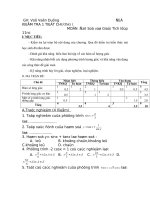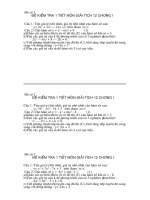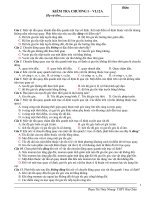ch1 1010
Bạn đang xem bản rút gọn của tài liệu. Xem và tải ngay bản đầy đủ của tài liệu tại đây (1.81 MB, 36 trang )
GEOLOGY-1010
•
•
•
•
INSTRUCTOR’S NAME: MARK BASKARAN
PHONE: 313-577-3262
E-MAIL:
OFFICE HOURS: 10:30-11:30 AM-M,F
Grading Policy – GEL-1010
•
•
•
LECTURE AND LAB MUST BE SUCCESFULLY COMPLETED
FIRST QUIZ.
GRADING
• EXAM #1=20%
• EXAM #2=20%
• FINAL =30%
• LAB =30%
COURSE GRADES WILL BE CURVED
•
•
•
•
EXAM WILL BE MULTIPLE CHOICE AND TRUE/FALSE
QUESTIONS
EXAM MATERIAL FROM LECTURE NOTES, DO NOT MISS
LECTURES
MAKE UP EXAM ………………..ONLY ON VALID EXCUSES
Lab
OPEN LAB (MAY ATTEND ANYTIME WHEN LAB IS
OPEN)
INTEGRAL
COURSE
AND ESSENTIAL PART OF GEL 1010
30%
OF FINAL GRADE – HELPS TO IMPROVE THE
GRADE
LAB
WILL START IN THE SECOND WEEK
MUST
HAVE PHOTO ID
LABORATORY
OUTLINE (BOOKSTORE OR
MARWELL’S) MUST BE BROUGHT TO THE LAB
20
– QUESTION QUIZ AT THE END OF EACH LAB
(COMPUTER TESTING; QUIZ WILL CONSTITUTE THE
GRADE FOR THE LAB)
*~ 3 HOURS – ALLOW 3.5 HOURS TO COMPLETE LAB
AND QUIZ
*NO FOOD/DRINK ALLOWED; NO VISITORS
ALLOWED
*NO LAB MAKEUPS
*LOWEST LAB WILL BE DROPPED.TOTAL 13 LABS –
1 DROP = 12 LABS
4 OR MORE LABS MISSING-MUST DROP THE COURSE
UNOFFICIAL WITHDRAWAL WILL BE GIVEN
*LAB STARTS ON TUESDAYS- ENDS THURSDAYMUST BE TAKEN THE SAME WEEK
TIPS FOR SUCCESS
READ
OUTLINE PRIOR COMING TO THE
LAB
REVIEW
MATERIAL IN TEXT BOOK
RELATED TO THE LAB TOPIC
FILL
IN OUTLINE CAREFULLY AS IT
WILL BE YOUR STUDY GUIDE FOR THE
QUIZ
ASK
LAB INSTRUCTOR IF THE LAB
MATERIAL IS UNCLEAR.
Methods of Science
• DATA GATHERING
• HYPOTHESES ( LOGICAL AND TENTATIVE
EXPLANATION )
( > 50 HYPOTHESIS FOR ICE
AGES )
• THEORIES ( GENERALLY ACCEPTED EXPLANATIONS)
• LAWS, SCIENTIFIC ( THEORY THAT MEETS RIGOROUS
TESTING)
• GEOLOGICAL MODELS
Scientific Theory
• MASSIVE VOLCANIC ERUPTIONS OF INDIA’S
DECCAN PLATEAU•
--------CLOUD OF V. ASH & GAS – COOLING –
DECLINE IN VEGETATION – PLANT EATING
ANIMALS WOULD HAVE DIED – MEAT EATERS
DEATH
• METEORITE IMPACT THEORY - ~ 10 KM
DIAMETER CRASHED INTO THE EARTH – DUST
VEIL & SMOKES FROM FIRE BLOCKED SUNLIGHT
Extinction of Dinosaurs
•
65 M YEARS AGO, 75% OF ALL FORMS OF LIFE VANISHED
( LAND & WATER – DWELLING)
•
EPEDEMIC DISEASES ELIMINATED DINOSAUR POPULATION?
•
EGG STEALING- MAMMALS RAVAGED DINOSAUR’S NESTS?
•
OCEANS BECAME LETHALLY SALTY – WHY SOME MARINE
ORGANISMS SURVIVED?
•
DRASTIC ENVIRONMENTAL CHANGE?
•
SHIFT IN PLANET’S PROTECTIVE MAGNETIC FIELD?
( ALLOWING HARMFUL RADIATION)
EVIDENCES
• *1” – CLAYEY LAYER ~ 65 M YEAR
•
CLAY CONTAINS IRIDIUM ( ABUNDANT IN METEORITE;
RARE IN INT. ROCKS)
( ABOVE THE LAYER ~ ONE FOURTH AS MANY
SPECIES)
• *PRESENCE OF TEKTITES ( GLASSY SPHERES ) IN
SEDIMENT LAYERS AROUND THE WORLD
( SUPER HEATED ROCKS AT IMPACT SITE HURLED
INTO THE AIR IN A MOLTEN STATE)
• *FOSSILS ABOVE & BELOW THIS 1”
Evidences – contd.
• *HIGH CONC. OF CARBON SOOT WITHIN THE
IRIDIUM LAYER
( EVIDENCE OF GLOBAL WILD FIRE)
*WHITISH FOSSIL – RICH LAYER AT THE
BOTTOM OF A CORE (ODP) IN ATLANTIC
OCEAN – OVERLAIN BY A THIN GRAY – GREEN
LAYER OF IMPACT DEBRIS TOPPED BY AN
IRON – RICH BAND – FOSSIL POOR LAYER
ABOVE.
*IMPACT SITE – YUCATAN’S CHICXULUB
CRATER 300 KM DIAMETER.
Big Bang Theory
•TIMING ESTIMATED USING HUBBLE SPACE TELESCOPE
-CURRENT POSITIONS & SPEED OF VISIBLE GALAXIES AS THEY MOVE
FROM ONE ANOTHER
•AFTER BIG BANG, UNIVERSE BEGAN TO EXPAND & COOL
•FEW MINUTES AFTER BIG BANG, UNIVERSE COOLED BY ABOUT
•ONLY PROTONS, NEUTRONS & ELECTRONS PRESENT
• ATOMS (BUILDING BLOCKS OF MATTER)
•ONLY WHEB UNIVERSE COOLED ~ 3000 DEG CENTIGRADE,
•H, He – LIGHT ELEMENTS BEGAN TO EXIST
Big Bang Theory
Lecture Outlines
Physical Geology, 10/e
Plummer, McGeary &
Carlson
Introducing Geology
Physical Geology 10/e, Chapter 1
Plummer et al.
Geology in Today’s World
• Geology - The scientific study of the Earth
– Physical Geology is the study of Earth’s materials,
changes of the surface and interior of the Earth, and the
forces that cause those changes
• Practical Aspects of Geology
– Natural resources
– Geological hazards
– Environmental protection
Practical Aspects of
Geology
• Natural Resources
– All manufactured objects
depend on Earth’s resources
– Localized concentrations of
useful geological resources
are mined or extracted
– If it can’t be grown, it must
be mined
– Most resources are limited in
quantity and non-renewable
Damage from Northridge (CA) earthquake
(1/17/1994) apartment-15 died
Resource Extraction and
Environmental Protection
• Coal Mining
– Careless mining can release acids
into groundwater
• Petroleum Resources
– Removal, transportation and waste
disposal can damage the
environment
Alaska pipeline
• Dwindling resources can encourage disregard for
ecological damage caused by extraction activities
Geologic Hazards
• Earthquakes
– Shaking can damage buildings and
break utility lines (electric, gas,
water, sewer)
• V olcanoes
– Ash flows and mudflows can
overwhelm populated areas
• Landslides, floods, and wave erosion
Geologic Hazards
• Earthquakes
– Shaking can damage buildings and
break utility lines (electric, gas,
water, sewer)
• V olcanoes
– Ash flows and mudflows can
overwhelm populated areas
• Landslides, floods, and wave erosion
Geologic Hazards
• Earthquakes
– Shaking can damage buildings and
break utility lines (electric, gas,
water, sewer)
• V olcanoes
– Ash flows and mudflows can
overwhelm populated areas
• Landslides, floods, and wave erosion
Physical Geology Concepts
•
Earth’s Systems
–
A tmosphere
•
–
Hydrosphere (rivers, ocean,
glaciers, lakes)
•
–
water on or near the Earth’s surface
Biosphere
•
–
the gases that envelop the Earth
all living or once-living materials
Geosphere
•
the solid rocky Earth
Physical Geology Concepts
• Earth’s Heat Engines
– External (energy from the Sun)
• Primary driver of atmospheric (weather) and
hydrospheric circulation
• Controls weathering of rocks at Earth’s surface
– Internal (heat moving from hot interior to
cooler exterior)
• Primary driver of most geospheric phenomena
(volcanism, magmatism, tectonism)
Earth’s Interior
• Compositional Layers
– Crust (~3-70 km thick)
• Very thin outer rocky shell of Earth
– Continental crust - thicker and less dense
– Oceanic crust - thinner and more dense
– Mantle (~2900 km thick)
• Hot solid that flows slowly over time; Fe-,
Mg-, Si-rich minerals
– Core (~3400 km radius)
• Outer core - metallic liquid;
mostly iron
• Inner core - metallic solid; mostly iron
Earth’s Interior
• Mechanical Layers
– Lithosphere (~100 km thick)
• Rigid/brittle outer shell of Earth
• Composed of both crust and
uppermost mantle
• Makes up Earth’s tectonic “plates”
– A sthenosphere
• Plastic (capable of flow) zone on
which the lithosphere “floats”









